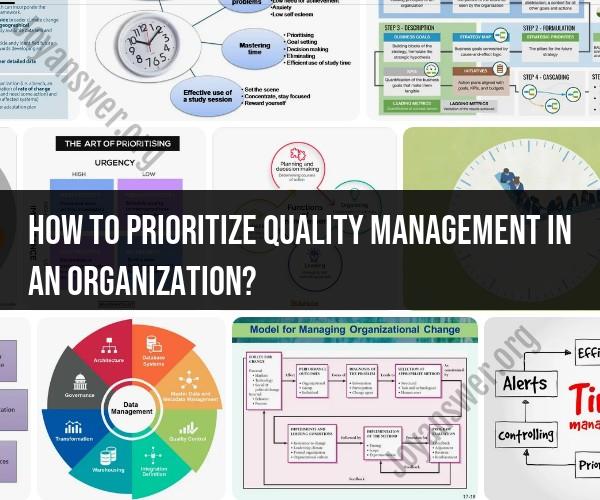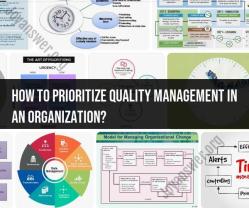How to prioritize quality management in an organization?
Prioritizing quality management in an organization is essential for delivering products and services that meet or exceed customer expectations, enhancing efficiency, and maintaining a positive reputation. Here are some strategies to prioritize quality management within an organization:
Leadership Commitment: Quality management starts at the top. The organization's leadership, including top executives and managers, must demonstrate a strong commitment to quality and lead by example. Their commitment sets the tone for the entire organization.
Quality Policy and Objectives: Develop a clear quality policy that outlines the organization's commitment to quality. Define measurable quality objectives that align with the organization's strategic goals.
Quality Management System (QMS): Implement a robust Quality Management System, such as ISO 9001, that provides a framework for quality management. Ensure that all employees are trained in the QMS and understand their roles in maintaining quality.
Customer Focus: Prioritize understanding and meeting customer needs. Regularly gather customer feedback and use it to drive improvement. Consider implementing a Customer Relationship Management (CRM) system.
Continuous Improvement: Foster a culture of continuous improvement. Encourage employees to identify and report issues, and provide mechanisms for them to suggest improvements. Implement methodologies like Lean Six Sigma to streamline processes.
Data-Driven Decision Making: Base decisions on data and facts rather than assumptions. Implement data collection and analysis tools to monitor and improve quality. Key Performance Indicators (KPIs) can help with tracking progress.
Employee Engagement: Engage employees by involving them in quality initiatives, seeking their input, and recognizing and rewarding their contributions to quality improvement.
Training and Development: Invest in ongoing training and development programs for employees. Ensure that they have the skills and knowledge to perform their jobs effectively and maintain quality standards.
Supplier Relationships: Collaborate closely with suppliers and establish quality requirements for the products and services they provide. Regularly assess and audit supplier performance.
Process Standardization: Standardize processes and document procedures to ensure consistency and reduce variability. Use process maps and Standard Operating Procedures (SOPs) to guide employees.
Root Cause Analysis: Implement root cause analysis techniques, such as the 5 Whys or Fishbone Diagrams, to identify the underlying causes of quality issues and prevent their recurrence.
Risk Management: Develop a risk management plan to identify and mitigate potential quality risks. Address risks systematically to prevent quality deviations.
Quality Audits and Reviews: Conduct regular internal and external quality audits to ensure compliance with quality standards and regulations. Review results to identify areas for improvement.
Certification and Accreditation: Pursue relevant quality certifications or accreditations to demonstrate the organization's commitment to quality, especially if your industry requires them.
Communication and Transparency: Maintain open and transparent communication within the organization about quality goals, progress, and challenges. This includes regular quality meetings and reporting.
Legal and Regulatory Compliance: Ensure that the organization complies with all relevant laws and regulations related to quality and safety.
Customer Education: Educate customers about the quality of your products and services. Clear communication regarding quality can build trust and loyalty.
Innovation: Encourage innovation to stay ahead of the competition and continuously improve quality.
Celebrate Quality Achievements: Recognize and celebrate quality achievements and milestones to motivate employees and reinforce the importance of quality.
By implementing these strategies and making quality a core part of the organizational culture, you can effectively prioritize and maintain a strong focus on quality management within your organization. Quality should not be viewed as a one-time initiative but as an ongoing commitment to delivering excellence.
Prioritizing Quality Management in Your Organization
Quality management is the process of overseeing all activities and tasks within an organization to ensure that products and services offered, as well as the means used to provide them, are consistent. Quality management is essential for any organization that wants to be successful in the long term.
There are a number of ways to prioritize quality management in your organization. One important step is to develop a quality policy. This policy should define what quality means to your organization and how you plan to achieve it. The policy should be communicated to all employees and should be reviewed and updated on a regular basis.
Another important step is to create a quality management system. This system should document your organization's quality processes and procedures. It should also include a process for identifying and correcting quality problems.
Finally, it is important to create a culture of quality within your organization. This means empowering employees to take ownership of quality and to continually look for ways to improve. It also means providing employees with the training and resources they need to be successful.
Benefits of Emphasizing Quality in Business Operations
There are many benefits to emphasizing quality in business operations. Some of the key benefits include:
- Increased customer satisfaction: Customers are more likely to be satisfied with products and services that are of high quality.
- Reduced costs: Quality management can help to reduce costs by preventing defects and reducing waste.
- Improved efficiency: Quality management can help to improve efficiency by streamlining processes and eliminating unnecessary steps.
- Increased productivity: Quality management can help to increase productivity by improving the quality of work output.
- Enhanced competitive advantage: Quality management can help organizations to gain a competitive advantage by offering products and services that are superior to those of their competitors.
Strategies for Implementing Quality Management
There are a number of strategies that organizations can use to implement quality management. Some of the most common strategies include:
- Total quality management (TQM): TQM is a comprehensive approach to quality management that focuses on continuous improvement in all aspects of the organization.
- Six Sigma: Six Sigma is a data-driven approach to quality management that focuses on eliminating defects and reducing variability in processes.
- Lean manufacturing: Lean manufacturing is a production system that focuses on eliminating waste and improving efficiency.
- ISO 9001: ISO 9001 is an international standard for quality management systems.
The best strategy for your organization will depend on your specific needs and goals. However, all of these strategies can be effective in helping organizations to improve their quality.
Measuring and Monitoring Quality in Your Organization
It is important to measure and monitor quality in your organization in order to identify areas where improvement is needed. There are a number of ways to measure quality, including customer surveys, employee feedback, and product and service inspections.
Once you have measured quality, you need to monitor it over time to see if your improvement efforts are having a positive impact. You can do this by tracking your quality metrics and looking for trends.
Achieving Excellence through a Quality-Centric Approach
By prioritizing quality management and implementing effective quality management strategies, organizations can achieve excellence. A quality-centric approach can help organizations to improve customer satisfaction, reduce costs, improve efficiency, increase productivity, and gain a competitive advantage.
If you are serious about achieving excellence in your organization, you need to make quality management a top priority. By doing so, you can create a sustainable foundation for long-term success.


